Network Rail submits plans for faste across the North England

Plans to deliver faster, more frequent rail travel across the North of England progressed today as Network Rail submitted an application for a new link connecting Manchester’s Piccadilly and Victoria stations – the Ordsall Chord.
The plans will ease a rail bottleneck to the south of Piccadilly station and enable more trains to travel through central Manchester. On completion in late 2016 / early 2017, it will provide:
- Two new fast trains per hour between Manchester Victoria and Liverpool
- Six fast trains, instead of four, an hour between Leeds and Manchester
- Faster journeys between Manchester, Leeds and Liverpool
- A new direct service through Manchester city centre to Manchester Airport
- Faster journey times to Hull, Newcastle and the North East
The application is a key part of the wider Northern Hub programme to deliver up to 700 additional trains on the network every day, providing space for around 44 million passengers a year, whilst stimulating much-needed economic growth. It is estimated the Northern Hub will generate over £4bn worth of economic benefits and create around 20,000 to 30,000 new jobs.
Following 18 months of consultation with local and regional stakeholders, the plans were submitted for consideration to the Transport and Works Act Unit within the Department for Transport. If permission is granted, work is expected to start in late 2014 / early 2015.
Dyan Crowther, Network Rail’s route managing director, said: “Britain relies on rail and with demand for rail travel increasing it’s essential we invest in the railway to provide a better service for passengers with more trains, additional seats and fewer delays.
ADVERTISEMENT
“Submitting the Ordsall Chord application is a key milestone for the Northern Hub programme. The new viaduct will unlock much-needed capacity on the rail network and deliver faster, more frequent services across the North, as well as stimulating low carbon economic growth.”

